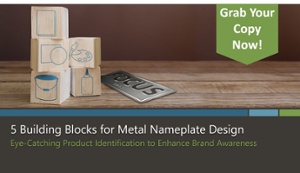There are steps to product design and bringing a product to market that are followed with each project. You've done the work to spec out materials and design for your product and have everything ready to launch into the market. Don't forget about the product identification! It is important to build your brand, communicate your message, and make a good impression in the market.
A nameplate is used to put your mark on your product. It is the method of telling consumers who you are, what your product is, and what value it brings to their life.
 Why is Branding Important?
Why is Branding Important?
Recently I read a really great review of how companies need a good brand strategy. When you think about it, every product on the shelf or that we see in media gives a certain perception about that product and company. That perception concept hit home with me and ties in with how nameplates and labels are all part of a brand strategy. Here is a quote from that piece:
"Branding gives companies a chance to let customers see the business for who we really are. This is the chance to be honest and open about what this company represents. The look, feel and message conveyed will separate you from the pack. " - article by Mike Tungate, Web Services Manager at Envision IT Solutions.
What a powerful statement! This speaks to all of the reasons to use a nameplate for product identification. A nameplate is more than just a sticker on a product that shows your logo. It relays feeling and promotes a message. It communicates information, builds credibility, makes you recognizable, and indicates the value of your product. Are you sending the right message to the market?
How Can We Help?
We are here to assist in options for great looking nameplates and labels that meet your branding goals. The possibilities are wide open - choose from metal or plastic substrates and send us your artwork with quantity requirements.
Related Posts
The Right Way to Design a Nameplate
3 Ways to Get Your Product Noticed
5 Reasons You Need a Nameplate
Originally published October 17, 2019, updated March 25, 2021 for clarity and resources.



